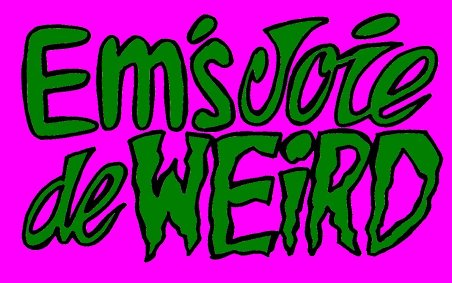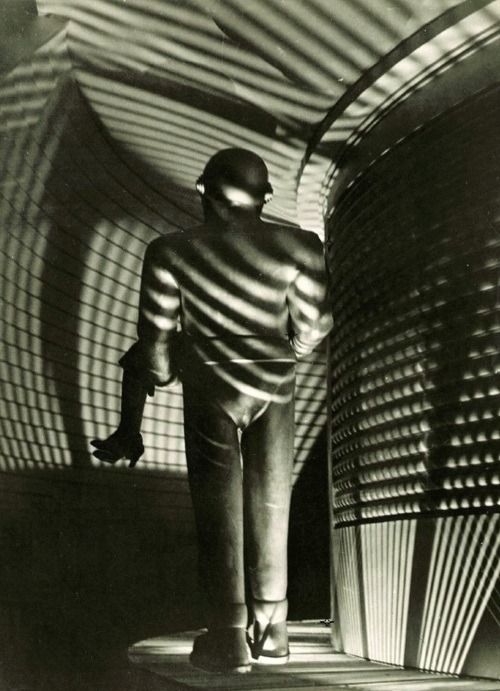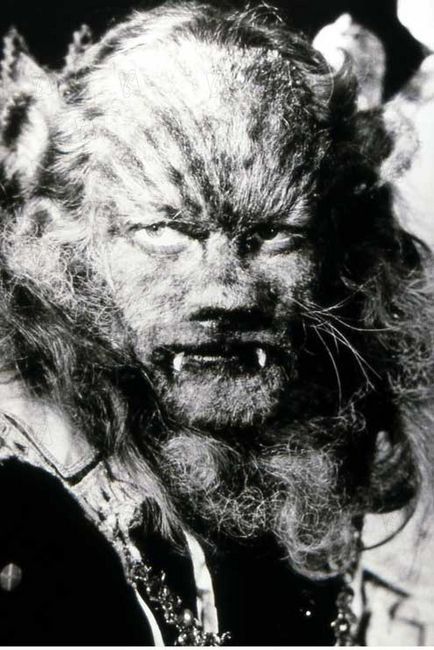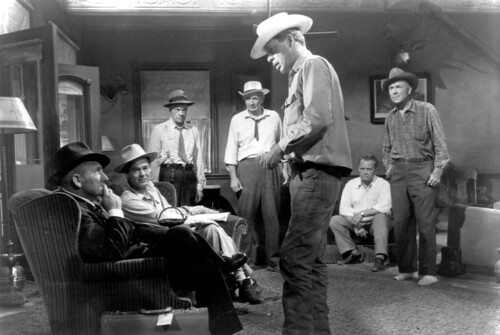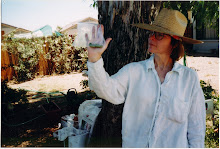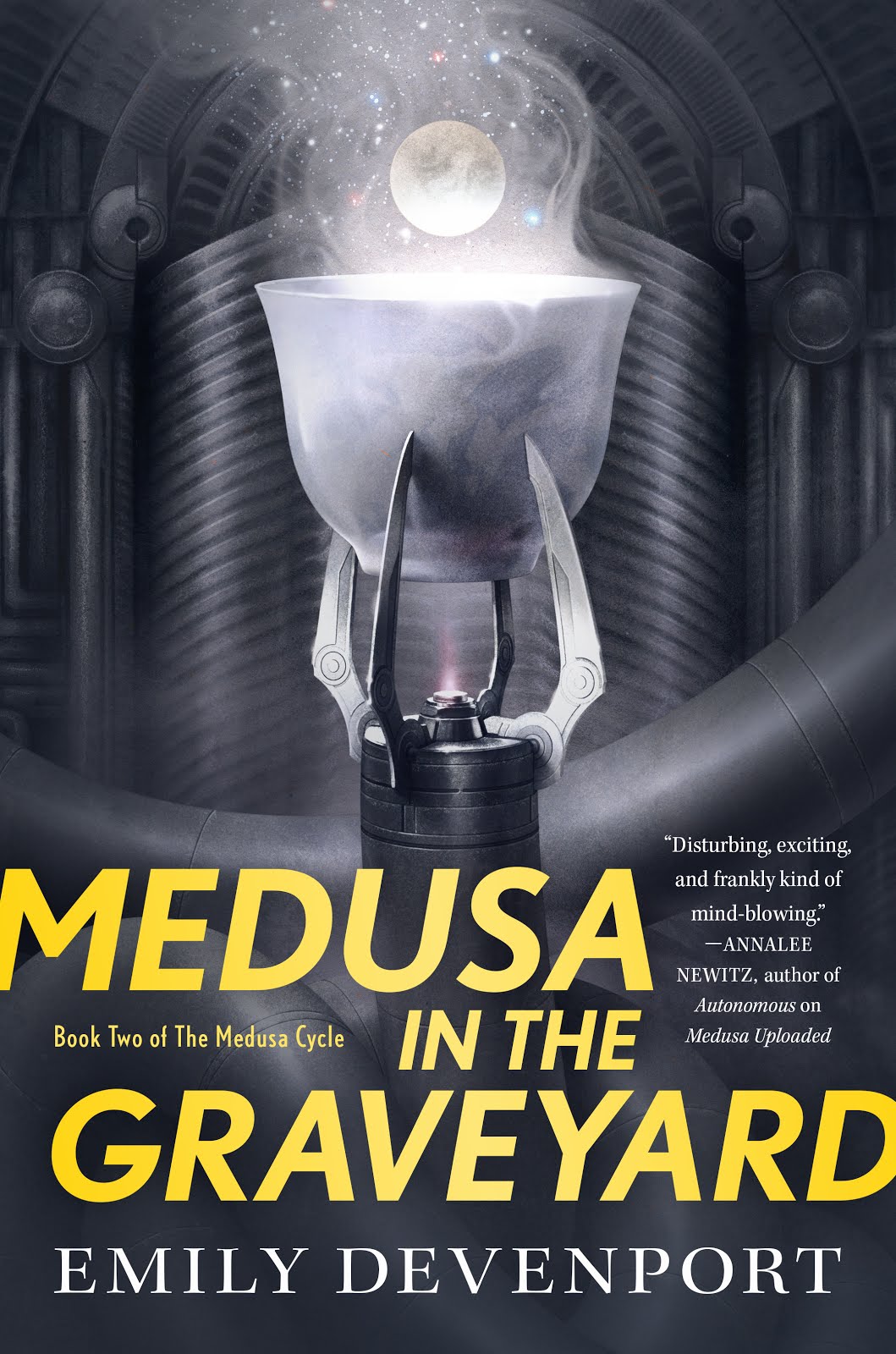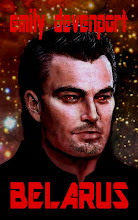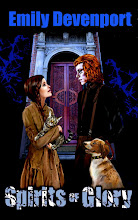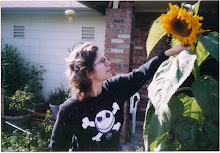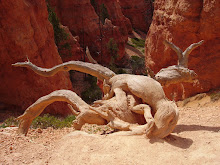Tuesday, July 24, 2012
Cosmic Dad And His Robot
In
my previous Best Movie blog
entries, I've mentioned scenes that I believe to be the heart of
those films, the essential expression of their nature. In La
Belle et La Bete, it's the scene
where Belle and the Beast walk together in the garden for the first
time. In Bad Day At Black Rock,
it's the scene where Macreedy delivers a karate chop to Trimble, proving that
one-armed war veterans should not be underestimated by small-town
thugs.
In
The Day The Earth Stood Still,
it's the scene where Klaatu signals Gort with the flashlight, then
enters his spaceship, while Bernard Herrmann's incomparable score
plays in the background (a segment called Nocturne/The Flashlight/The Robot/Space Control). With no dialog, it
manages to convey a supreme sense of wonder as we're invited into
that alien ship to glimpse the Unfathomable.
Like
Rear Window, The
Day The Earth Stood Still has no
wasted scenes, every frame counts. The difference is that the score
forThe Day The Earth Stood Still is
an integral part of the movie – it's essential to help tell the
story. Movies like this are one of the reasons music videos
eventually became so popular – images and sounds, when combined,
are powerful storytellers.
In
a way, it's surprising this movie ever got made. It's based on a
classic science fiction story, “Farewell To The Master,” (Harry Bates, 1940) which has a very different
plot. Only the basic premise of an alien visitation remains the
same, and the fact that there's a robot. These are nerdy elements,
and in those days they were usually relegated to the realm of the B
movie. YetThe Day The Earth Stood Still was made by an
A-list director, Robert Wise – which is why it also earned an A-list
composer for the score, and an excellent cast and script (Edmund H. North).
Many
people have seen a parallel to the storyline of the film and the
Jesus parable, with Klaatu as the Messiah. At one point, he is
killed and resurrected. But though Klaatu is ethical and wise beyond
Human standards, his message is not one of joy and peace. Basically
he's on Earth to tell us, Look, you're a bunch of destructive
yahoos. If you're so petty and foolish that you have to keep killing
each other, that's your business. But if you bring your conflicts
out into space, we'll blast you into oblivion. The choice is yours.
He
doesn't deliver that ultimatum until the very end of the movie – up
until that point, most of the humans he encounters spend their time
proving that his lack of faith in us is utterly justified. People
react fearfully, and the government fails to approach Klaatu with
diplomacy (they opt for the Scorched Earth approach). A few of the
people he meets manage to win him over. You never get the impression
that he hates us, just that he's disappointed that we can't grow up
and get a clue. Heck, I'm disappointed by that, too. Being a member
of the Human Race is like having a cousin who's a great guy –
unless he's drinking.
Both
Michael Rennie and Patricia Neal give their characters extraordinary depth. They come from a time when “The Theater”
included plays acted on stage. In the early days of Hollywood,
casting directors recruited heavily from a stable of extremely well-
trained and talented character actors from that earlier tradition.
This is one of the things that puts the Day The Earth Stood Still
in a category above many of the Science fiction B films of that
era (fun and imaginative though they could be).
The
special effects are fairly minimal – just some minor animation when
Gort disintegrates guns and tanks (also a soldier or two when the
going gets tough). Everything else is camera angle, lighting, great
editing, perfect music. I'll take these old-fashioned psychological
effects over CGI any day.
Beyond
the fact that it's a great Science Fiction movie,The Day
The Earth Stood Still has a
personal dimension for me. The first time I saw it, I was about
eight years old, and my father didn't live with us. He and my mother
had divorced a few years before, but I didn't know that. He served
in the air force, and the Viet Nam war was still going on. I knew my
father was deployed there, so I assumed he wasn't home because he was
fighting in that war. I was only half right.
In
the movie, Klaatu befriends a boy. His behavior toward that boy is
fatherly, and I've always sensed a bit of romance between Klaatu and
Patricia Neal's character. When I saw Klaatu get into his ship at
the end of the movie and fly away, leaving the woman and her boy
behind, it broke my heart. It still does, every time I see it.
Monday, July 16, 2012
Where Is My Beautiful Beast?
Jean
Cocteau's La Belle et La Bete
is on a lot of Best Movie lists, sometimes for snooty reasons. After
all, it's foreign (that'll get you 4 stars right there), it's French
(there are a whole class of movie critics who like nothing but) –
and it's relatively old (made just after WWII), so it qualifies as a
“classic.” But sweep aside all that pseudo-intellectual noise,
and you're still left with a magnificent movie.
I
discovered it accidentally. Most of the people I grew up with, went
to school with, worked with, never knew it existed – and if they
had known, they might have thought it was dumb and boring because
there weren't any car chases or explosions. Plus you have to read
subtitles – what a bummer!
But
there are times in your life when you're ripe for magic. I was
fourteen, and I had my own (black & white) TV in my bedroom. I
loved that thing, because it showed me worlds far outside my little
Phoenix suburb. One night I was surfing (in this case, actually
turning a dial), and I landed on our local PBS station. I saw a
beautiful woman entering what looked like a haunted castle.
Disembodied arms held candelabra in the entryway, and she glided
along the hallway outside her bed chamber as if the floor were
moving. There was no sound, and when she turned to run from the
castle, she moved in slow motion. When she got to the courtyard, she
was confronted by a magnificently dressed man with the head of a
lion. She fainted. He picked her up and carried her back into the
castle.
That
was IT, my friends. That scene was like an arrow to my heart. No
way was I going to touch that dial until the movie was over. It
replayed the next night, so I watched it from beginning to end. No
other attempt to film the story of Beauty And The Beast
has even come close to it. No other attempt ever will. There are
several reasons why.
Maybe
the essential reason is Jean Cocteau. He was like an author writing
a book. This makes sense when you consider that he was a novelist,
painter, playwright, and poet, besides being a filmmaker. Though he
was a poet, he knew that pursuing poetry too enthusiastically can
cause it to elude you completely. And I suspect that the romance in
La Belle et La Bete was more personal for Cocteau than it
ever was for other directors who filmed the story of Beauty And
The Beast. Of all the characters in his film, the one he seemed
to relate to the most was Belle, played by Josette Day. In his book
about making the movie, Diary Of A Film, Cocteau wrote a
little note about Josette. He said she looked like he had when he
was younger. When you consider that his lover and lifelong friend
Jean Marais played both the Beast and the other man who loved Belle (Avenant), this little note takes on extra significance.
Considerable
credit for the look of La Belle et La Bete belongs to Christian Berard, the art director, and Henri Alekan, the cinematographer (just two of of the artists/technicians who deserve credit).
According to Cocteau's own diary, he did not always agree with his
team, and often felt frustrated with them. Yet he persevered in his
collaboration with them, trooping forward even though he suffered from bouts of illness. The production was an expensive challenge,
he really had to improvise to get supplies, line up shooting
locations (many of the beautiful garden scenes were shot at the Chateau de Raray), and design special effects. Though it may seem like
filming the production in black & white was an artistic choice,
he indicates in Diary of a Film that he would have preferred
color – it just wasn't an option in post-war France. It's hard to say
what that color production would have looked like – the black &
white turned out gorgeous.
The acting is superb. And the folktale was originally adapted for print by two Frenchwomen, so perhaps Cocteau was sensitive to what was between the lines. But two
things that really make the movie stand head and shoulders (and
mane?) above other versions are the “creature” design for the
Beast and the beautiful score by Georges Auric. The Beast was so
splendid in his velvet outfit and starched collar, so perfect as a
lion, it makes you sad when he eventually metamorphoses into a man at
the end. This outcome is not helped by the fact that Jean Marais is
wearing those silly pantaloons that look like the little tents that
go on the end of Thanksgiving drumsticks. Legend has it that Marlene Dietrich, after witnessing this transformation during a screening in Paris, asked, “Where is my Beautiful Beast?” I'm inclined to agree.
Georges Auric's score is also on my list of top ten scores. I love it from
beginning to end, but one segment haunts me – the scene where Belle
and the Beast walk together in the garden for the first time.
There's something timeless and magnificent about that scene – I
think it's the heart of the movie.
Great
books, music, and movies are made by brilliant people who are unique
because they are a product of their particular place and time.
That's why other attempts to reproduce what they've done are
unsuccessful. No one will ever write a fantasy likeThe Lord Of
The Rings, because Tolkien was a British man who was born in
South Africa near the end of the 19th century, emigrated
to England, and eventually served in the trenches of World War I.
Likewise, Cocteau and his team of filmmakers had their unique
experiences and vision (not to mention their own Great War). The result of their collaboration is a movie
that will be loved as long as people are still watching movies. It's
magic truly is timeless.
Tuesday, July 3, 2012
Bad Day At Black Rock
If
you've never seen Bad Day At Black Rock,
you may assume someone named Bad Bart is prominently featured in the
story, along with a shootout at high noon. You'd be wrong on both
counts. You'd also be wrong if you assumed it was an old-fashioned
Western. It's more of a new-fashioned Western, set in an Arizona
town that's little more than a dent by the side of the road, just
after WWII. That great war may seem like a simple background detail
at the beginning of the movie. It's anything but.
Every
time I see this movie, I try to figure out where it was filmed. Some
of the rock formations look like Southern Arizona. It was actually filmed in the Mojave, but it could be one of several Southwestern locations, a desert with vast, empty
space between each town. Space may represent freedom in some
circumstances, but in this case it's more of a prison for Macreedy, who
can't survive that huge stretch of arid desert if he isn't in a train
or in a car with plenty of gas. Since he's arrived on the train, and
it won't be back for a few days, he's got to survive until it does –
and that turns out to be a huge challenge.
The
Bad Guys know Macreedy is a threat to their secret from the moment he gets
off the train, yet they underestimate him – and the audience may
feel the same way, at first. Macreedy lost an arm in the war, and he's one
guy against many. He has courage and integrity, and he's smart, too
– possibly too smart for his own good. He asks few questions, but
those questions are too perceptive. He sees the trap closing around him,
but he doesn't knuckle under. Instead, he keeps thinking. He reacts
calmly to the bluster of bullies and never shows them the fear they'd
really like to see. This keeps them guessing long enough to buy him
a little time. But will it be enough?
You
may think you know how things are going to turn out, but Macreedy has at
least one trick up his sleeve that will have you cheering. He is a
hero, someone who learned to fight in the war. If this movie had
been made after 1970, it probably would have been spoiled by having Macreedy beat all the bad guys up with kung-fu expertise. Hollywood has
really lost its ability to depict heroes realistically. True heroism
is when you're facing down unfair odds and getting your head handed
to you on a platter, yet you still try to do the right thing.
The score was composed by Andre Previn, who "deals in the realm of creating tension and release in his sonic dramas," according to reviewer Lindsay Planer on Allmusic.com.
The score was composed by Andre Previn, who "deals in the realm of creating tension and release in his sonic dramas," according to reviewer Lindsay Planer on Allmusic.com.
The
casting of Bad Day At Black Rock is a who's who of great
character actors. Ernest Borgnine is a perfect bully. Robert Ryan is
chilling as the Boss behind the scenes, the guy who has always run
the show in that unhappy little corner of the world. Anne Francis is best
known for her role in Forbidden Planet, but she shows a much
broader range here as a woman trapped between a rock and a hard
place. Dean Jagger is a ruined marshal who regrets trading his soul for the
bottle. And no one could play Macreedy better than Spencer Tracy. He's
another actor from the Golden Age of Hollywood, when they were
willing to cast leading men who didn't have perfect faces and bodies.
It's the force of his personality that makes him stand out from the
crowd.
As
we get further into the 21st century, those of us who grew
up in the shadow of WWII are starting to die off. Many young viewers
may miss the point of Bad Day At Black Rock – that a
Japanese-American soldier wants his father to have the purple heart
he earned fighting for his country. The internment camps are still
discussed in history class, but if you don't know someone who went
through that, if you didn't go through it yourself, it's hard to
understand why someone got killed because of what was going on back
home – or why the killers would kill again to keep the secret.
This movie is a window into those times. Look through it, and maybe
you'll understand why Bad Day At Black Rock is on my Best
Movies list.
Subscribe to:
Posts (Atom)
